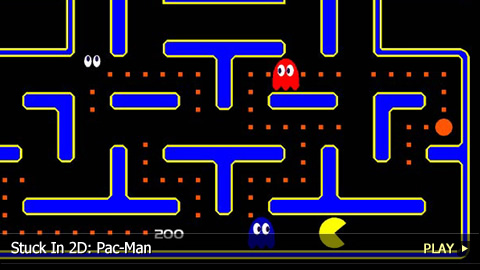Stuck In 2D: Pac-Man

Stuck In 2D: Pac Man
Over the years many iconic video game franchises have tried and failed miserably to enter the 3rd Dimension. Welcome to WatchMojo.com, and today we’re taking a look at the Pac-Man Franchise’s attempts to break from its 8-bit past.
One of the first video game mascots, and arguably one of the most popular, Pac-Man and his simple, yet addictive maze games have captivated gamers for decades.
First released in 1980 by Namco for the arcades, the game has since been ported to dozens of gaming platforms and computers and has become recognized as the world’s most successful video game.
Its popularity has been attributed to its gender-neutral design and addictive gameplay that centers on navigating a never-ending series of stages. Throughout the game you must eat all of the yellow dots that you encounter, while avoiding and defeating the 4 ghosts that stand in your way.
While Pac-man remained insanely popular following its initial leap to the home consoles and the computer, Namco eventually found itself under pressure to take Pac-Man into the third dimension.
As a result, Pac-Man joined the other gaming mascots in the 3rd Dimension in his own free roaming platformer simply called “Pac-World” in 1999 for the original Playstation.
While not a bad game, it had far less appeal to gamers as the 3D adventures Mario and Zelda, and gamers remained skeptical, as they didn’t see a need for Pac-Man to have arms and legs or a detailed plot. So despite being a decent game, it failed to give the yellow dot the comeback he deserved.
Unfazed, Namco tried again in 2002 with “Pac-Man World 2” for the PlayStation 2 and N64 Consoles. Eager to please their fan-base, the game’s level design was made far more varied and interesting and the pace was improved. Overall, the game was praised for its retro-inspired presentation that better managed to incorporate the iconic designs of the franchise’s past within a modern game.
Unfortunately, Namco stumbled with their third Pac-Man World game in 2005, as the title had too many technical flaws, and was regarded as a lazy follow-up that was far too easy and generic.
At the same time, they took a different root for their portable title Pac N’ Roll for the Nintendo DS. The game returned the character to his limbless state and took the focus away from platforming and had gamers roll him like a ball through obstacles.
Next, Namco put their Mascot in a go-cart for “Pac-Man World Rally” in 2006, and it was harshly criticized for being nothing more then a Mario Kart clone.
In light of their lukewarm attempts at 3D, the franchise returned to its old-school roots as a downloadable Xbox Live title called “Pac-Man Championship edition.” The game shifted its focus to online multiplayer, and minor aesthetic updates, such as a new wide-screen board, techno beats and dazzling neon lights.
The problem facing the franchise is the fact that it was designed as a straightforward maze game. As a result, Pac-Man is perhaps best left in his original form, which is just as fun today as it was when the game arrived in the early 80s.
